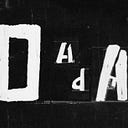A conversation with Alexander Reben
Alex Reben is an artist and roboticist whose work explores humanity through the lens of art and technology. He developed DADAGAN, a bot that learned to draw from the dataset of 115,000 drawings made by artists on DADA. At CADAF we presented a series of prints of responses of DADA artists to the DADAGAN’s drawings. For the occasion, we had a brief chat with Alex.
How would you describe GANs for dummies?
A GAN stands for Generative Adversarial Network and is a machine learning technique for generation of content. It works by using two systems, one which tries to make convincing output by learning from a dataset and another which judges if the output is real or not. The generator keeps adapting to try to fool the tester and eventually it makes output that is fairly convincing.
What is it that you enjoy about working with GAN technique as an artist?
GANs are interesting because the output, while in the same style as the input, is almost always surprising and interesting.
What are the misconceptions people have about AI generative art?
People tend to give generated content more credit than they should as far as it’s “intelligence” goes. It is natural for people to want to anthropomorphize technology.
Indeed, someone asked us: “I’m curious what type of parameters DADAGAN is set to so he doesn’t go too far, doesn’t disobey, nor do anything unwanted cause of an oversight in the programming”. They were quoting Isaac Asimov’s rules for robots, “particularly where they are supposed to obey their master.”
How has our view of robots evolved?
Right now “AI” is not smart, at all. For very thinly defined problems, it works well, but AGI (Artificial General Intelligence) is quite far away, if it is ever achieved. Also, the system is not a robot, there is no physical component, there is no way for it to interact with or modify the world.
How do you feel about this particular DADA dataset and how is it different from others?
The DADA dataset was very diverse, which can be both a good and bad thing. It’s good because there is a lot of variety to learn from, and it’s bad because it is hard to “converge” on. So, the output that the model generates is quite abstract, however, this aligns with the spirit of DADA.
Still, some of the output veers into the figurative. In a relatively short time, it could draw human faces and some creatures that look like animals. How do you imagine DADAGAN evolving?
There is more that can be done by cleaning up and sorting through the data set. For instance, it can be trained on drawn faces, or many images of a particular style.
It’s hard not to antropomorphize DADAGAN, because it’s easy to play around with the idea that it is making art. Where do you draw the line?
We see many things as alive, it is part of our social and survival instincts. Drawing a line is a philosophical question which comes down to each individual’s interpretation of life and consciousness.
At CADAF, it was very interesting to see the reactions of people to our “conversations” between artists and DADAGAN. Many people think that the bot is more precise since it’s a machine so they guess that the human art was made by DADAGAN, others spot the human hand more easily, but most agree that it isn’t easy to spot. That is the uncanny part.
